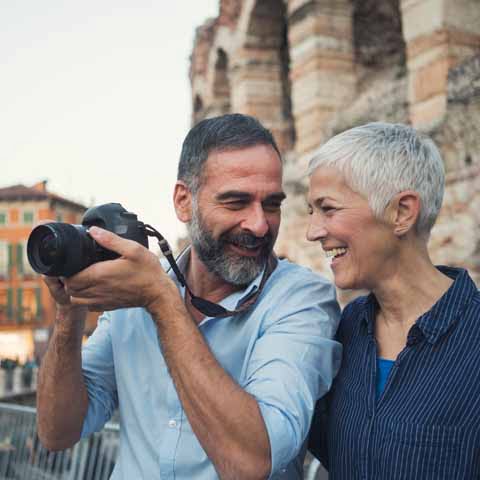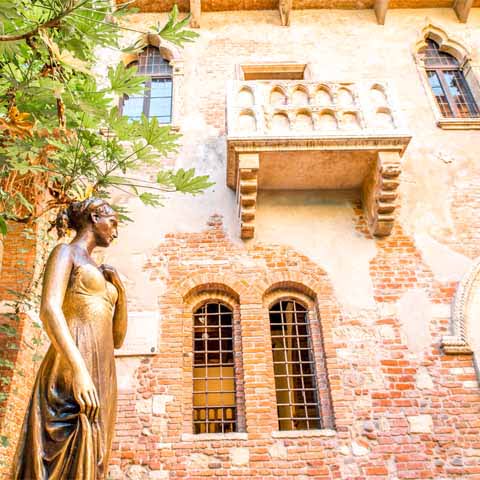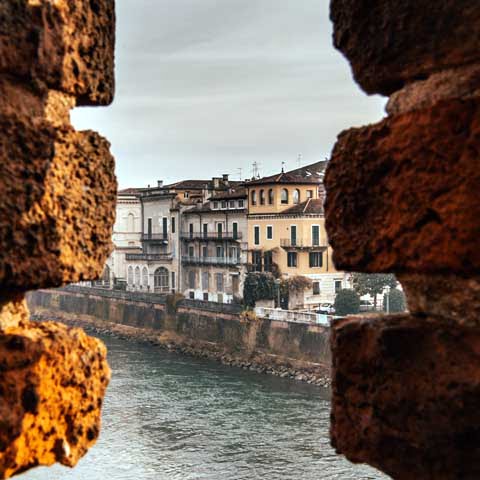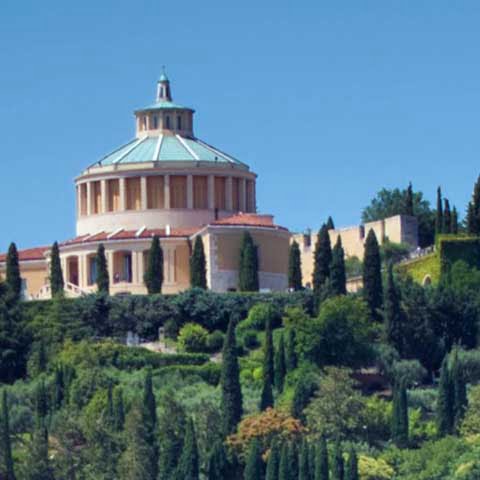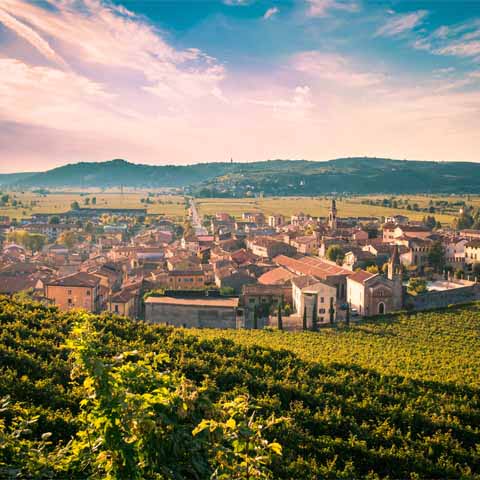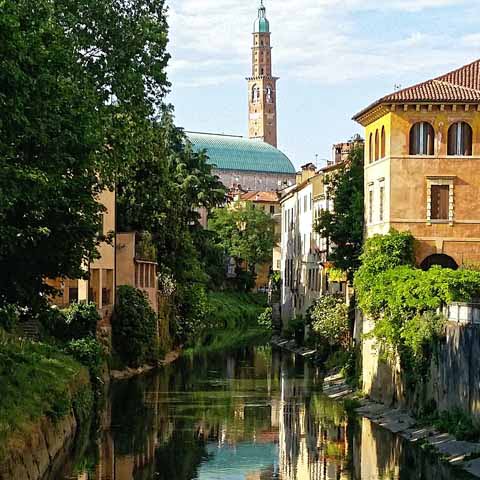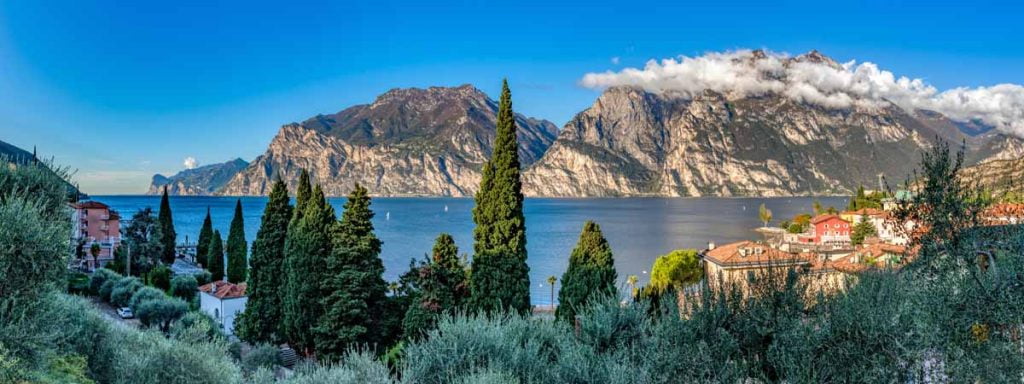Known for its amazingly well-preserved Roman amphitheater and close associations to the works of William Shakespeare, it’s no wonder that Verona is a top cultural destination in Italy. With centuries of history seen via its architectural structures, museums, and artwork housed in museums, palaces, and more, Verona is ideal for those seeking cultural enrichment.
ARCHITECTURE
The historical center of Verona has been deemed a UNESCO World Heritage Site due to its vast array of architectural sites. From splendidly preserved Roman monuments to intact medieval and Renaissance structures, the city houses amazing and one-of-a-kind buildings and monuments.
By far the most impressive and popular architectural destination in Verona is its famed Arena, or Roman amphitheater. Located in the heart of the city, this outdoor Roman amphitheater is a testament to the history of Verona. Able to contain approximately 15,000 people, the arena was constructed in the early first century AD. It was once used for massive live gladiator battles and is actually still in use today for live public events, namely concerts and opera performances. The Verona amphitheater is the third largest of its kind and is said to have been able to hold the entire population of Verona during Roman times.
Other architectural landmarks throughout Verona include Ponte di Pietra (a Roman stone bridge), the Arco dei Gavi (first century AD Roman arch), the Roman Theater, Porta Borsari – the façade of the original gate that served as the entrance through the Roman city walls, and the spectacular Verona Cathedral – known for its stunning work by Niccolò, one of the most notable Italian Romanesque sculptors of his time. The Verona Cathedral consists of several architectural styles including a Romanesque exterior, Gothic interior, and a Renaissance presbytery. The church’s origins date back to the twelfth century, though it has since been renovated several times, most notably during the fifteenth century. During a seventeenth century renovation, a Baroque upper part was added to the façade. The bell tower, though incomplete, is decorated with bas-reliefs.
The town is also known for its many historic churches. Located along the Adige River, San Fermo Maggiore features two churches, an upper and lower church, each of which feature unique characteristics. The upper church is more medieval in appearance and includes frescoes dating to the fourteenth century, whereas the lower church is less opulent, featuring simpler design elements.
San Giorgio in Braida is a domed Renaissance style structure housing important works of art such as Martyrdom of St. George by Paolo Vernonese and Baptism of Christ by Tintoretto. The Church of San Zeno Maggiore, dedicated to the city’s Patron Saint, is one of the country’s most opulent and detailed churches. It features an ornate façade, Romanesque and Gothic cloisters, and eleventh century bronze doors. The church served as the setting of Romeo and Juliet’s marriage in Shakespeare’s play. Another key Romanesque church is the Basilica of San Lorenzo. Dating back to the end of the twelfth century, the unique construction of the church features alternating stone and brick, creating stripes throughout the exterior and interior.
Principal among Verona’s civic medieval architecture is the Torre dei Lamberti. Measuring approximately 275 feet tall, this impressive tower has become a symbol of the city. The tower was damaged by lightning during the fifteenth century and was subsequently reconstructed. The exterior, which features brick and stone, is similar in design to the Basilica of San Lorenzo. It is possible to climb to the top of the tower and enjoy remarkable panoramic views of Verona’s city center.
Another key medieval monument is the Castelvecchio Bridge, which connects to Castelvecchio castle. Composed of red brick and white marble and currently spanning nearly 400 feet, Castelvecchio Bridge was the longest bridge in the world when its construction was completed. Unfortunately, this bridge and Ponte Pietra were both destroyed by German troops during World War II, though both were later reconstructed.
Also worth a mention are the city’s stunning main squares, which serve as a gathering place for locals and visitors alike. The largest square in Verona is Piazza Bra, which is home to the Arena di Verona and the city hall in Palazzo Barbieri. Additionally, the square features a garden area, an iconic fountain, and a monument dedicated to King Vittorio Emanuele II. As the very heart of Verona, Piazza Bra is always buzzing with locals and visitors.
The other main square, Piazza delle Erbe, has origins that date back to the time of the Roman Empire, when it served as Verona’s forum. Within the vicinity of the square, travelers will find a number of cafés, shops, and historic buildings. Among the monuments to admire here are the Torre dei Lamberti, the Baroque Palazzo Maffei, the Mazzanti Houses, and the fountain.
Adjacent to Piazza delle Erbe, is the medieval Piazza dei Signori. Though smaller than Piazza Bra and Piazza delle Erbe, Piazza dei Signori features several important historic buildings including Palazzo della Ragione, Palazzo Cansignorio, the Romanesque Church of Santa Maria Antica, Palazzo del Podestà, and Loggia del Consiglio. The focal point of the square is the statue of Dante that watches over all passersby.
ART
Much of Verona’s art scene dates back to Roman times and beyond. Travelers can experience top notch museums featuring collections of countless historical treasures.
A must-see for art lovers is the Museo di Castelvecchio. Built in the early 1300s by the powerful Scaglieri dynasty, this medieval castle houses one of the Veneto region’s finest art galleries. Within the museum are a wide selection of art from the medieval period to the eighteenth-century including paintings, sculptures, and antiques ranging from weapons to ceramics to full suits of armor. In addition to gazing upon the museum’s fantastic collection, travelers will enjoy the amazing views of the castle itself.
Palazzo Forti is the place to visit for fans of modern art. This private collection features approximately 1,600 works ranging from the nineteenth century to today with artists such as Francesco, Hayez, Felice Casorati and Mario Mafai represented.
One of Verona’s most unique artistic destinations is the former convent San Francesco al Corso, which has since been transformed into a travel destination where visitors can see the final resting place of Juliet from the famed Shakespearean play Romeo and Juliet. While Juliet is a fictional character, the legend of the tale lives on in the hearts of millions throughout the world, and the open sarcophagus at this locale has been deemed her gravesite, since the former monastery was the setting of the play’s turbulent fifth act. The locale also features a fresco museum. Contained within it are frescoes from various Veronese buildings dating back to the medieval period through the sixteenth century. Inside the church are massive works, and beneath it is a collection of Roman sculpture and medieval lapidary material.
Another excellent art gallery is the Museo e Pinacoteca Canonicale. The large collection features paintings and sculptures from the fifteenth and sixteenth centuries. There are also works by local Veronese artists from the thirteenth century and earlier.
For unparalleled ancient art, head to the Lapidary Museum Maffeiano. Located in Piazza Bra, this museum is home to an impressive collection of Etruscan, Greek, and Roman sculptures, carvings, and inscriptions.
LITERATURE
One cannot speak of Verona without acknowledging Shakespeare’s influence. Two of the playwright’s works – Romeo and Juliet and The Two Gentlemen of Verona – are set in Verona, and as a result his works have drawn countless visitors to the city. In fact, many couples choose to visit Verona to celebrate marriages, honeymoons and anniversaries because the city has become a representation of one of the world’s most impactful and famous love stories.
Those with a passion for Romeo and Juliet will love visiting some of Verona’s sites dedicated to the tale. Travelers can visit the houses of Romeo and Juliet, the latter featuring the famous balcony from the play’s most revered scene. Visit the Basilica of San Zeno Maggiore, which is the locale of the couple’s forbidden marriage, while the Monastery and Church of San Francesco al Corso features the tomb of Juliet in one of the cloisters.
Theatrical literature is celebrated during the Estate Teatrale Veronese (Verona Summer Theatre Season). Held each summer at the Roman Theater, the event features dramatic works as well as fascinating dance and music performances.
Verona was also the birthplace of several poets including Latin poet Catullus, Romantic poet Ippolito Pindemonte, Neo-romanticist Aleardo Aleardi, and Berto Barbarani, who wrote in the Veronese dialect. Among Verona’s most important native writers are Francesco Scipione Maffei, a playwright and art critic, and Emilio Salgari, one of Italy’s most iconic authors known for his adventure stories and science fiction work that continues to influence Italian popular culture.
MUSIC
Music is celebrated in Verona during the summer when the city hosts its annual opera festival. Held in the Verona Arena over the course of several months, the event features the most iconic operas as well as classical music concerts and ballet performances. Giuseppe Verdi’s Aida is a staple of the event each year. The annual event is attended by opera lovers from all over the world and tickets tend to sell out quickly.
Another place to enjoy and celebrate music is the Arena Museo Opera, a multimedia exhibition located in Palazzo Forti that celebrates Italy’s long history of opera. Included are original scores and letters from composers such as Puccini and Verdi as well as iconic costumes, set pieces, and photos from famous operas.
Additionally, Verona was the birthplace of several noteworthy composers including Renaissance composers Paolo Bellasio, Stefano Bernardi, Marc’Antonio Ingegneri, Bartolomeo Tromboncino, and Vincenzo Ruffo as well as Baroque composer Marcantonio Negri and nineteenth century opera composer Carlo Pedrotti. Famed classical composer Antonio Salieri was born in the town of Legnago, which is located approximately 30 miles south of Verona.
CINEMA
As the iconic setting of Shakespeare’s Romeo and Juliet, much of Verona’s cinematic history centers on film adaptations of the famous play. These range from early twentieth century silent films to several Italian and international productions in subsequent decades including George Cukor’s Romeo and Juliet (1936), Renato Castellani’s Giulietta e Romeo (1954), Riccardo Freda’s Romeo e Giulietta (1964), Franco Zeffirelli’s Romeo e Giulietta (1968), and Carlo Carlei’s Romeo & Juliet (2013).
A few other movies have been filmed, either fully or partially, in Verona including The Lovers of Verona (1949), Fabiola (1949), Barabbas (1961), Rome Adventure (1962), Arrivano i gatti (1980), and Letters to Juliet (2010).
SCIENCE
Verona’s Museo Civico di Storia Naturale (Civic Natural History Museum) is a wonderful locale for science buffs to immerse in the natural history of the area. Founded in 1853, the museum houses collections of Veronese plants, animals, fossils, minerals, and other paleolithic and Neolithic findings from around Verona. Located in a stunning sixteenth century palace, the Civic Natural History Museum is perfect for those interested in biological, geological, and botanical history.
Roman history buffs will delight at the Museo Archeologico al Teatro Romano, a museum located near the Roman theater that contains historical artifacts such as pottery, artwork, and more from the Roman period.
A truly unique experience is the Museo della Radio – a museum that features a collection of old radios. Dedicated to a famous engineer and inventor, Guglielmo Marconi, the museum is unique and intriguing.
Additionally, Renaissance physician and mathematician Girolamo Fracastoro was born in Verona. Fracastoro was a proponent of atomism and his work studying the transmission of syphilis is an early contribution to the field of epidemiology.
Internationally renowned for its Roman ruins and medieval architecture, Verona is so much more than simply the setting of Romeo and Juliet. Though many travelers are initially attracted to the city because of the famous play, they end up falling in love with Verona’s wealth of art, architecture, history, and musical heritage.
The Cities of Veneto, Italy
Don't just see Italy, live it.
Your dream trip to Italy has never been closer
No more endlessly scrolling travel sites. Our travel experts will craft the perfect, one-of-a-kind trip just for you.

300+
DESTINATIONS
We offer more Italian destinations than any travel site. Do and see more with Trips 2 Italy.
1 (of a kind)
ITINERARIES
Because your dream trip to Italy should be designed for you, not for the masses.
100%
PEACE OF MIND
From flights and accommodations, to food and activities - we take care of every detail.
